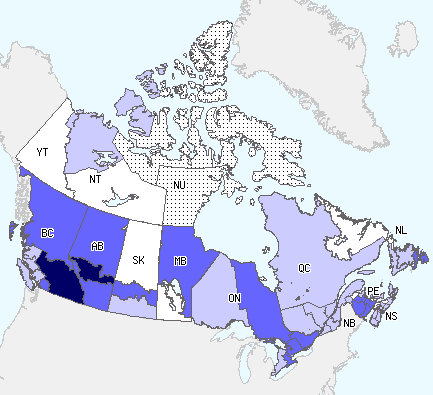Common menu bar links
E-mail this page
 |
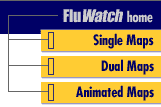
|
February 15, 2009 to February 21, 2009 (Week 7) |
Fluwatch
Overall influenza activity in Canada continues to increase
During week 07, influenza activity in Canada continued to increase: 2 regions (in BC & AB) reported widespread activity, 16 regions localized (in BC, AB, SK, MB, ON, NB & NL), 25 regions sporadic and 8 regions reported no activity (see map). Note that no report was received from Nunavut this week. The proportion of tests that were positive for influenza continued to increase (percentage positive = 16.8%; 914/5,431) (see table). Although the majority of influenza virus detections to date this season were influenza A viruses (57% or 1,936/3,405) detections for influenza B viruses are also increasing (see graph). This week, the ILI consultation rate declined to 23 ILI consultations per 1,000 patient visits (see ILI graph) which is within the expected range. The sentinel response rate was 57%. In week 07, 33 new influenza outbreaks were reported: 5 in LTCFs (BC, AB, SK & ON), 1 in a hospital (in AB) and 27 in schools (BC, AB, NB & NS).
Antigenic Characterization:
Since 1 September 2008, the NML has antigenically characterized 356 influenza viruses: 85 influenza A/Brisbane/59/2007(H1N1)-like (from BC, AB, SK, ON, QC, NS & PEI), 49 influenza A/Brisbane/10/2007(H3N2)-like (from BC, AB, SK, ON, QC, PEI & NL), 6 influenza B/Florida/4/2006-like (from AB, ON & QC) and 216 B/Malaysia/2506/2004-like (in all provinces except the Territories). A/Brisbane/59/2007(H1N1), A/Brisbane/10/2007(H3N2) and B/Florida/4/2006 are the influenza A and influenza B components recommended for the 2008-09 influenza vaccine. B/Malaysia/2506/2004 was the influenza B component for the 2007-2008 season vaccine (see pie chart).
Antiviral Resistance:
Results from the NML:
Since the start of the season, the NML has tested 174 influenza A isolates (95 H1N1 and 79 H3N2) for amantadine resistance. All of the H1N1 isolates were susceptible; however all of the H3N2 isolates were resistant to amantadine (resistance = 100% or 79/79). The resistant isolates were from BC, AB, SK, ON, QC, PEI, NL & NT.
The NML has also tested 308 influenza isolates (81 A/H1N1, 40 A/H3N2 & 187 B) for oseltamivir (Tamiflu) resistance. All of the A/H3N2 and B isolates were sensitive; however all of the A/H1N1 isolates were resistant to oseltamivir due to the H274Y mutation (resistance = 100% or 81/81). The resistant isolates were from BC, AB, SK, ON, QC, NS & PEI.
All 301 influenza isolates (74 A/H1N1, 40 A/H3N2 & 187 B) tested for zanamivir resistance to date were sensitive to zanamivir.
Oseltamivir resistance findings from Provincial laboratories:
To date this season, 96 influenza isolates in BC have been sub-typed as A/H1 and were assessed genotypically for oseltamivir resistance using an SNP assay. Eighty-six isolates tested positive for the H274Y mutation (resistance = 100% or 86/86), with the other 10 specimens still pending confirmatory testing.
Influenza-associated Paediatric Hospitalizations:
In week 07, 15 laboratory-confirmed influenza-associated paediatric hospitalizations were reported through the Immunization Monitoring Program Active (IMPACT) network. The cases were from AB, ON, QC & NS and 73% were due to influenza A. To date, 141 hospitalizations have been reported of which 72% (102/141) have been due to influenza A. The proportion of cases to date by age group are as follows: 21% were 0-5 month olds; 17% were 6-23 month olds; 14% were 2-4 year-olds; 13% were 5-9 year-olds; and 34% were 10-16 year-olds. The distribution of cases to date by province are as follows: 7% from BC, 12% from AB, 1% from SK, 1% from MB, 56% from ON, 20% from QC & 3% from NS.
International:
WHO: During the weeks 05 to 06, the level of overall influenza activity in the world continued to increase.
CDC: During week 06, influenza activity continued to increase in the United States; 1,313 (24.4%) specimens tested positive for influenza, of which 69% were influenza A and 31% were influenza B. Testing for antiviral resistance indicated that of the influenza virus A/H1N1 tested, 98.5% were resistant to oseltamivir and 0.7% resistant to amantadine. Of the influenza A/H3N2 viruses tested for resistance, 100% were resistant to amantadine. All tested viruses remain sensitive to zanamivir. To date this season, 9 influenza-associated pediatric deaths have been reported to the CDC (5 of which were reported in week 06). Bacterial coinfections were confirmed in 6 (66.7%) of the 9 children; Staphylococcus aureus was identified in 4 (66.7%) of the 6 children. An increase in the number of influenza-associated pediatric deaths with bacterial coinfections was first recognized during the 2006-07 influenza season.
EISS: Similar to the previous week, influenza activity continued to increase in central and eastern Europe and continued to decrease in western Europe. Influenza A(H3N2) continues to be the dominant influenza virus circulating in Europe however the proportion of influenza B detections per week continues to show a rising trend, with an increasing number of countries reporting influenza B as the dominant or co-dominant virus type. Of the 198 A(H3N2) isolates that were tested for adamantanes susceptibility, 198 (100%) were resistant. Of the 146 A(H1N1) virus isolates tested for resistance against neuraminidase inhibitors, 143 (98%) were resistant to oseltamivir, but all were sensitive to zanamivir.
Human Avian Influenza: Since 21 February 2009, no new cases of human H5N1 avian influenza infection have been reported by the WHO; however the WHO did report the deaths of two previously reported cases from Viet Nam.
Total number of influenza tests performed and number of positive tests by province/territory of testing laboratory, Canada, 2008-2009
| Province
of reporting laboratories |
Report Period: February 15, 2009 to February 21, 2009 |
Season to Date: August 24, 2008 to February 21, 2009 |
||||||
| Total
# Influenza Tests |
# of Positive Tests | Total
# Influenza Tests |
# of Positive Tests | |||||
| Influenza A | Influenza B | Total | Influenza A | Influenza B | Total | |||
NL |
44 | 13 | 1 | 14 | 399 | 27 | 5 | 32 |
PE |
11 | 2 | 0 | 2 | 139 | 10 | 6 | 16 |
NS |
59 | 3 | 5 | 8 | 582 | 21 | 18 | 39 |
NB |
87 | 23 | 15 | 38 | 648 | 62 | 40 | 102 |
QC |
2355 | 284 | 202 | 486 | 17220 | 855 | 444 | 1299 |
ON |
1420 | 57 | 146 | 203 | 18260 | 339 | 732 | 1071 |
MB |
69 | 4 | 0 | 4 | 1351 | 8 | 4 | 12 |
SK |
233 | 6 | 8 | 14 | 2954 | 30 | 30 | 60 |
AB |
988 | 80 | 11 | 91 | 13485 | 337 | 120 | 457 |
BC |
165 | 39 | 15 | 54 | 1606 | 247 | 70 | 317 |
Canada |
5431 | 511 | 403 | 914 | 56644 | 1936 | 1469 | 3405 |
Specimens from NT, YT, and NU are sent to reference laboratories in other provinces.
Note: Cumulative data includes updates to previous weeks; due to reporting delays, the sum of weekly report totals do not add up to cumulative totals.
Abbreviations: Newfoundland/Labrador (NL), Prince Edward Island (PE), New Brunswick (NB), Nova Scotia (NS), Quebec (QC), Ontario (ON), Manitoba (MB), Saskatchewan (SK), Alberta (AB), British Columbia (BC), Yukon (YT), Northwest Territories (NT), Nunavut (NU)
Respiratory virus laboratory detections in Canada, by geographic
regions, are available weekly on the following website:
<http://www.phac-aspc.gc.ca/bid-bmi/dsd-dsm/rvdi-divr/index-eng.php>
Number of influenza surveillance regions† reporting widespread or localized influenza activity, Canada, by report week, 2008-2009 (N=54)
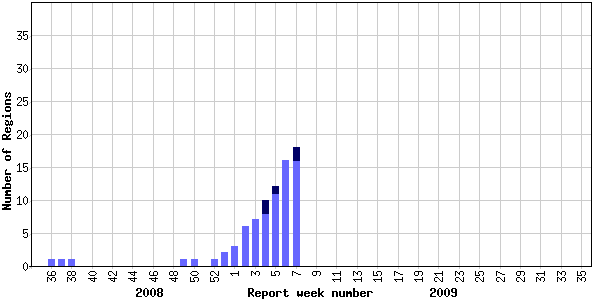
![]()
† sub-regions within the province or territory as defined by the provincial/territorial epidemiologist. Graph may change as late returns come in.
Note: Influenza activity levels, as represented on this map, are assigned and reported by Provincial and Territorial Ministries of Health, based on laboratory confirmations, sentinel ILI rates (see graphs and tables) and outbreaks. Please refer to detailed definitions. For areas where no data is reported, late reports from these provinces and territories will appear on the FluWatch website. Select single maps by report week to get this updated information.
<http://dsol-smed.phac-aspc.gc.ca/dsol-smed/fluwatch/fluwatch.phtml?lang=e>
Click on the map to view provinces/territories and maps for other weeks.
Influenza tests reported and percentage of tests positive, Canada, by report week, 2008-2009

Percent positive influenza tests, compared to other respiratory viruses, Canada, by reporting week, 2008-2009
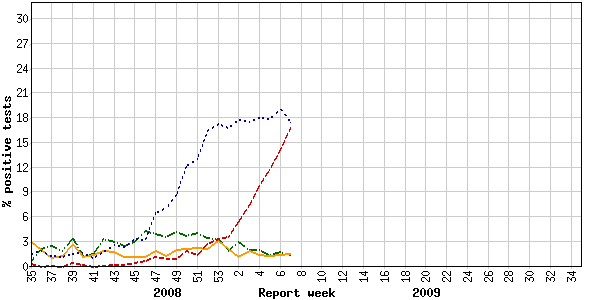
![]()
Influenza strain characterization, Canada, cumulative, 2008-2009 influenza season by the Respiratory Viruses Section at the National Microbiology Laboratory
[N=356]

{Strain characterization, number identified, per cent of total number}
NACI recommends that the trivalent vaccine for the 2008-2009 season in Canada contain
A/Brisbane/59/2007 (H1N1)-like virus; an A/Brisbane/10/2007 (H3N2)-like virus; and a B/Florida/4/2006-like virus.
Influenza-like illness (ILI) consultation rates, Canada, by report week,
2008-2009 compared to 1996/97 through to 2007/08 seasons
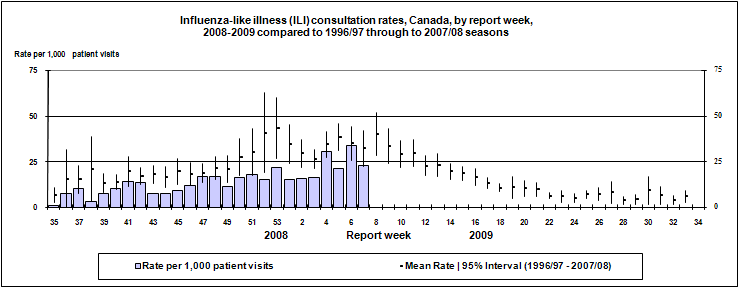
Note: No data available for mean rate in previous years for weeks 19 to 39 (1996-1997 through 2002-2003 seasons).
Number of New Outbreaks in Long Term Care Facilities, Canada, by Report Week, 2008-2009

Please note that the above graphs may change as late returns come in.

